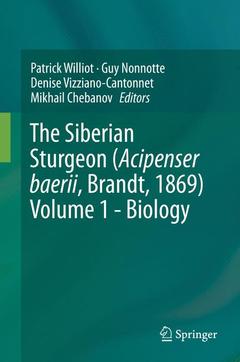The Siberian Sturgeon (Acipenser baerii, Brandt, 1869), 1st ed. 2018
Coordonnateurs : Williot Patrick, Nonnotte Guy, Vizziano-Cantonnet Denise, Chebanov Mikhail

This two-volume book set focuses on the Siberian sturgeon. Acipenser baerii Brandt 1869, one of the 27 ?existing? sturgeon species, is a native species of the Siberian catchments, where ? as in many other parts of the world ? the sturgeon populations are now threatened. Sturgeon farming practices targeting caviar and meat production have been expanding worldwide since the 1990s, and have seen a further increase since the turn of the century. Among the handful of sturgeon species used for significant production, the most dominant is the Siberian sturgeon. Given its peculiar phylogenetic position as a chondrostei and its use as a biological model in e.g. France, the species has also attracted the attention of biologists.
The aim of the editors was to provide for the first time a comprehensive and updated synthesis regarding the farming-related biology of the Siberian sturgeon. In light of the abundance of material, it has been divided into two volumes, with a focus on biology and farming, respectively. The main parts of Volume 1 are Biology and ecology, Biology and physiology of reproduction, and Ecophysiology, i.e. adaptation to the environment. In turn, Volume 2 is divided into six parts: Reproduction and early ontogenesis, Growing, Global production, Long-term management of brood stock, State of health through welfare and immunology, and Ecological risks of installation in non-native waters, illustrated by two long-term documented examples in Russia and France.
Patrick Williot
Patrick took on the challenge of preventing the disappearance of the critically endangered European sturgeon and developing sturgeon farming. To do so, he mobilized all the means of research, including the use of biological models of the Siberian sturgeon. He was the kingpin of the First International Symposium on Sturgeon held in Bordeaux in 1989. In 2007, he succeeded in achieving the controlled reproduction of farmed European sturgeon for the first time. He has strongly supported Siberian sturgeon farming in France. Patrick has edited several peer-reviewed books and proceedings on aquaculture and conservation biology, mainly on sturgeon, and published over 90 papers in peer-reviewed journals or books.
Guy Nonotte
Researcher at the CNRS, with a PhD from the University of Strasbourg, Guy NONNOTTE has pursued research on fish physiology i.e. ionic regulation, respiration, extracellular acid-base balance and cell volume regulation in freshwater and sea-water fishes exposed to environmental changes and pollutants with a specific interest in the model « Siberian sturgeon ». He supervised a thesis on the toxicity of ammonia for the Siberian sturgeon in collaboration with Dr. Patrick Williot. In 1994, he was appointed Professor of Animal Physiology at the University of Brest (France) and Emeritus Professor of this University in 2007. He has published more than 100 articles in international reviews and supervised numerous theses on fish ecophysiology.
Mikhail Chebanov
Dr.Sc., Professor at the Aquatic Bioresources and Aquaculture Department of Kuban State University and Director of State Centre for Sturgeon Gene Pool Conservation, Russia. He received an award from the Government of Russia in Science for developing technology for the year-round reproduction of sturgeon and for the global implementation of ultrasound for breeding stock man
This set of two volumes provides a comprehensive synthesis on the biology, farming, management and restoration programs of the Siberian sturgeon
Volume 1. “The Siberian sturgeon (Acipenser baerii Brandt, 1869) – Volume 1 – Biology”
Provides a comprehensive synthesis of the sturgeon’s biology, including: Biology and Ecology, Physiology of Reproduction, and Ecophysiology, i.e. adaptation to the environment
Shares detailed insights on unusual topics and/or updated syntheses, e.g. species-specificity, new insights on mineralization and ossification, genetic sex determination, transposable elements in gonads, early ontogeny, sensory capacity, nutrition, swimming, chemical neuroanatomy of the central nervous system, oogenesis with the unique simultaneous description by image and physiological phenomena, gonadal steroids, steroid profiles, physiological effects of environmental stress (hypoxia and exposition to ammonia particularly), as well as selected methods (aortic cannulation, respiration physiology)
Intended for fish biologists, specialists in comparative biology and/or evolutionary biology, sturgeon scientists, sturgeon farmers, and consultants in a variety of fields, e.g. in aquaculture, farming design, and water management
Volume 2. “The Siberian sturgeon (Acipenser baerii Brandt, 1869) – Volume 2 – Farming”
Provides comprehensive information on sturgeon farming, including: Reproduction, Food and Feeding, Long-term Management of Brood Stock, State of Health, and Ecological Risks
Shares detailed insights on unusual topics and/or updated syntheses, e.g. controlled reproduction and related issues, fish meal replacement, endocrine disruptions, prebiotics and immunostimulants, off-flavor management, global production of meat and caviar, hybrids, welfare, immunology, ecological risks of installation, as well as selected methods (in vitro incubation of ovarian follicles, richly illustrated library of echographs allowing non-i
Date de parution : 04-2018
Ouvrage de 1087 p.
15.5x23.5 cm



